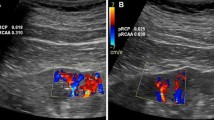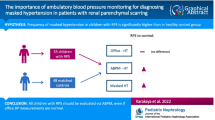Abstract
Renal scarring is known to be associated with hypertension. The primary objective of this study was to investigate the prevalence of renal scarring in children referred to our clinic with hypertension. The secondary objective was to compare renal ultrasound (US) examination with dimercaptosuccinic acid (DMSA) renal scan in diagnosing renal scars in these patients. The study included 159 patients who underwent DMSA renal scan as well as renal US for the evaluation of hypertension of unknown etiology. Thirty-three (21%) patients were found to have renal scars; their demographic details, including mean age and gender distribution, were not significantly different from those without renal scars. In comparison with the DMSA renal scan, sensitivity and specificity of renal US in diagnosing renal scars were 36% and 94%, respectively. In our study, in which the prevalence of scarring was 21%, this gave positive predictive and negative predictive values of 63% and 85%, respectively. In conclusion, our study indicates that renal scarring is present in 21% of otherwise healthy children who are evaluated for newly diagnosed hypertension, and renal US is not a sensitive imaging modality to rule out renal scarring.
Similar content being viewed by others
References
Sorof JM, Lai D, Turner J, Poffenbarger T, Portman RJ (2004) Overweight, ethnicity, and the prevalence of hypertension in school-aged children. Pediatrics 113:475–482
Arar MY, Hogg RJ, Arant BS Jr, Seikaly MG (1994) Etiology of sustained hypertension in children in the southwestern United States. Pediatr Nephrol 8:186–189
Falkner B, Sadowski RH (1995) Hypertension in children and adolescents. Am J Hypertens 8:106–110
Hanna JD, Chan JC, Gill JR Jr (1991) Hypertension and the kidney. J Pediatr 118:327–340
Lahdes-Vasama T, Niskanen K, Ronnholm K (2006) Outcome of kidneys in patients treated for vesicoureteral reflux (VUR) during childhood. Nephrol Dial Transplant 21:2491–2497
Bhatnagar V, Mitra DK, Agarwala S, Kumar R, Patel C, Malhotra AK, Gupta AK (2002) The role of DMSA scans in evaluation of the correlation between urinary tract infection, vesicoureteric reflux, and renal scarring. Pediatr Surg Int 18:128–134
Smellie JM, Shaw PJ, Prescod NP, Bantock HM (1988) 99mTc dimercaptosuccinic acid (DMSA) scan in patients with established radiological renal scarring. Arch Dis Child 63:1315–1319
National High Blood Pressure Education Program Working Group on Hypertension Control in Children and Adolescents (1996) Update on the 1987 Task Force Report on High Blood Pressure in Children and Adolescents: a working group report from the National High Blood Pressure Education Program. Pediatrics 98:649–658
Schwartz GJ, Brion LP, Spitzer A (1987) The use of plasma creatinine concentration for estimating glomerular filtration rate in infants, children, and adolescents. Pediatr Clin North Am 34:571–590
Piepsz A, Tamminen-Mobius T, Reiners C, Heikkilä J, Kivisaari A, Nilsson NJ, Sixt R, Risdon RA, Smellie JM, Söderborg B (1998) Five-year study of medical or surgical treatment in children with severe vesico-ureteral reflux dimercaptosuccinic acid findings. International Reflux Study Group in Europe. Eur J Pediatr 157:753–758
Mitsnefes MM (2006) Hypertension in children and adolescents. Pediatr Clin North Am 53:493–512, viii
Soergel M, Schaefer F (2002) Effect of hypertension on the progression of chronic renal failure in children. Am J Hypertens 15:53S–56S
Vachvanichsanong P (2007) Urinary tract infection: one lingering effect of childhood kidney diseases–review of the literature. J Nephrol 20:21–28
Graves JW, Althaf MM (2006) Utility of ambulatory blood pressure monitoring in children and adolescents. Pediatr Nephrol 21:1640–1652
Milosevski G, Kostic M, Babic D, Jovanović O, Kruscić D, Stanić M, Peco-Antić A (2005) Classic and automated blood pressure monitoring in children with scarring nephropathy. Srp Arh Celok Lek 133:417–423
Patzer L, Seeman T, Luck C, Wuhl E, Janda J, Misselwitz J (2003) Day- and night-time blood pressure elevation in children with higher grades of renal scarring. J Pediatr 142:117–122
Simoes e Silva AC, Silva JM, Diniz JS, Pinheiro SV, Lima EM, Vasconcelos MA, Pimenta MR, Oliveira EA (2007) Risk of hypertension in primary vesicoureteral reflux. Pediatr Nephrol 22:459–462
Rushton HG, Majd M, Jantausch B, Wiedermann BL, Belman AB (1992) Renal scarring following reflux and nonreflux pyelonephritis in children: evaluation with 99mtechnetium-dimercaptosuccinic acid scintigraphy. J Urol 147:1327–1332
Moorthy I, Wheat D, Gordon I (2004) Ultrasonography in the evaluation of renal scarring using DMSA scan as the gold standard. Pediatr Nephrol 19:153–156
Temiz Y, Tarcan T, Onol FF, Alpay H, Simsek F (2006) The efficacy of Tc99m dimercaptosuccinic acid (Tc-DMSA) scintigraphy and ultrasonography in detecting renal scars in children with primary vesicoureteral reflux (VUR). Int Urol Nephrol 38:149–152
Marra G, Oppezzo C, Ardissino G, Dacco V, Testa S, Avolio L, Taioli E, Sereni F; ItalKid Project (2004) Severe vesicoureteral reflux and chronic renal failure: a condition peculiar to male gender? Data from the ItalKid Project. J Pediatr 144:677–681
Author information
Authors and Affiliations
Corresponding author
Rights and permissions
About this article
Cite this article
Ahmed, M., Eggleston, D., Kapur, G. et al. Dimercaptosuccinic acid (DMSA) renal scan in the evaluation of hypertension in children. Pediatr Nephrol 23, 435–438 (2008). https://doi.org/10.1007/s00467-007-0656-2
Received:
Revised:
Accepted:
Published:
Issue Date:
DOI: https://doi.org/10.1007/s00467-007-0656-2




